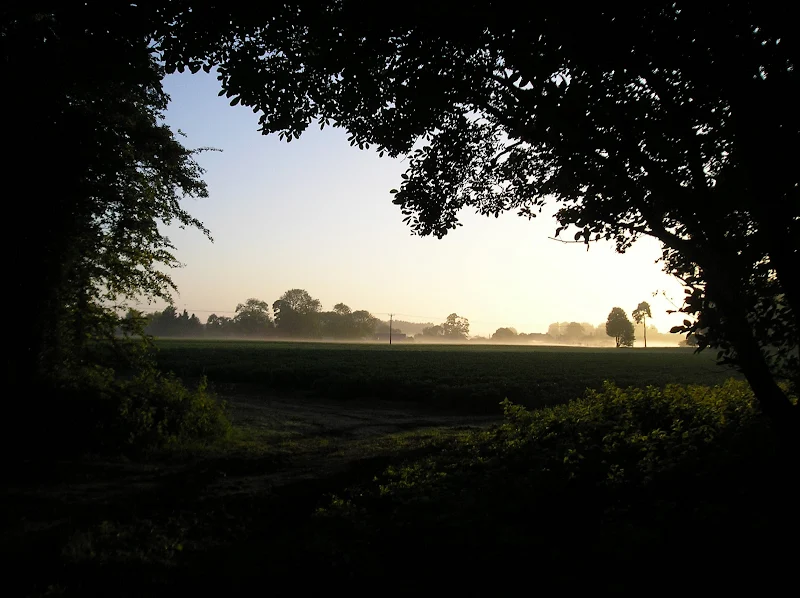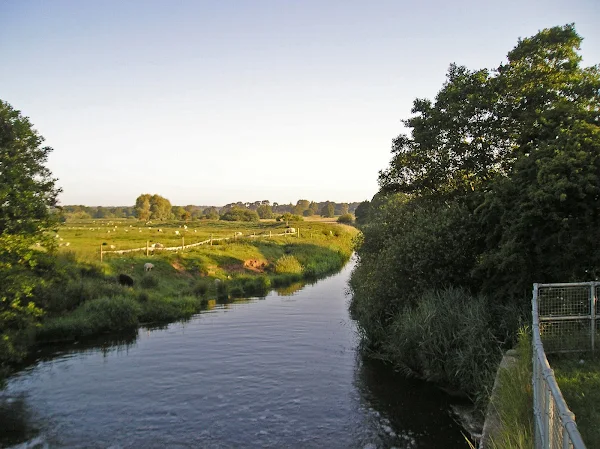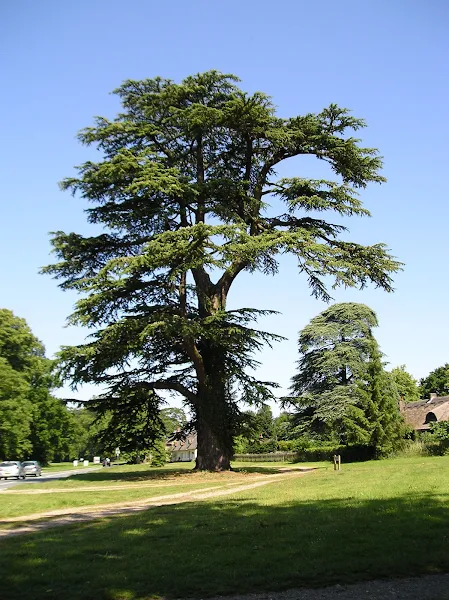The Icknield Way - Herringswell to Knetishall Heath

A 25 mile walk along the Icknield Way between Herringswell and Knetishall Heath
This section of the Icknield Way reveals just how remote some areas of Suffolk can be. Apart from a couple of isolated hamlets there is nothing but forest trails and fields for the full 25 miles through to Knettishall Heath. This is perfect for those who like the solitude but one does need to make sure ample food and water supplies are taken for this lengthy hike.

Walk Statistics
- Start location: Woods south of Herringswell
- End location: Dower House Campsite, Knetishall Heath
- Distance: miles ( km)
- Total Gain: ft ( metre)
- Total Descent: ft ( metre)
- Min Height: ft ( metre)
- Max Height: ft ( metre)
- Est. Walk Time:
- Walk type: Linear
- Walk Grade: Hard on the feet due to the rock-hard tracks
- Terrain:
Maps
The following maps and services can assist in navigating this route. There are links to printed maps and links to downloadable GPX route data for importing into navigational software and apps.
- Ordnance Survey Explorer Map
- OS Explorer 210 - Newmarket & Haverhill
- Ordnance Survey Explorer Map
- OS Explorer 229 - Thetford Forest in The Brecks
- GPX Route File
Accommodation
The Dower HouseCamp siteView in OS Map | View in Google Map
- Website
- http://www.dowerhouse.co.uk/
- Description
- The Dower House Campsite
Walk Notes
This is the final section of the Icknield Way from Buckinghamshire to Norfolk, which provides a link to the Ridgeway and Peddars Way National Trails. The previous evening had resulted in a wild camp in the woods close to Herringswell due to the lack of availability of accommodation. At first light the camp was packed and the area left like I had never even been there. Not a soul was around. Perfect.
The previous day had been hot. Very hot. This day was going to be even warmer and starting early would give an advantage of getting some miles in before the heat of the day. Of particular concern was water supplies, with under a litre of water left and no substantial civilisation being passed on route.
A mist hovered above the fields which presented a magical scene one could only stand and gaze at in wonder. The track from the woods leads into Herringswell and the Icknield Way then continues onto the village of Tuddenham. There was a half hope that maybe a newsagent would be encountered at Tuddenham where I could buy some water, but no such luck. A small terrier type dog gave chase to me as I headed out of the village down the lane towards Icklingham. Yapping and snapping like little dogs do. The lane out of Tuddenham is a long straight single track leading through to the River Lark then on into the village. From the map it appears that there should be a bridge across the river but as I came closer there was no sign of a bridge and thoughts crossed my mind of having to swim or wade across the water. The expected location of the bridge revealed nothing but a single large pipe spanning the river below. Probably a water or gas main. The sight was disheartening. The track led around to the left, following the river up stream. Then there, a few yards onwards was a simple footbridge. A relief!
The village of Icklingham provided another chance to find a newsagent for water supplies. No such hope! The traditional early morning newsagent appears to have disappeared from existence in the wilds of Suffolk. This really was the last chance and there would be no more signs of civilisation until Knetishall at the end of the hike. The trail heads along field boundaries to the east of the village, navigating along tracks and footpaths before turning north to lead through the Kings Forest. I found a point along these initial paths to sit down and the dewy grass and grab a bite to eat from the rucksack supplies that had been garnered from previous days walk. An orange. Several cereal bars. All washed down with a little water, leaving nearly half a litre. A whole day of hot sunshine was ahead. A big concern.
The last footpath joins a substantial track that leads into the forest and at this junction was a parked car where a couple were getting ready to walk their dog, kit being deployed from the hatchback. They offered a friendly hello
and from their accent is was clear they were of American origin. I offered a reply which struck up more conversation. The man remarked on the weather forecast, declaring it would be the hottest day of the year, and on learning of my days hike proffered the requirement to have enough water. I showed him my last bottle and gave a little concern at this lasting the day. Without hesitation he walked to the drivers door and pulled out one of two half litre water bottles and insisted I take one. What a relief! I could not thank them enough. It was going to be a life saver that was for sure.
The King’s Forest was named to commemorate the Silver Jubilee of King George V and Queen Mary. The track that the Icknield Way uses runs directly through the forest in a long and straight line, south to north, for nearly 4 miles. Either side of this broad thoroughfare are regimented trees standing in ordered lines interspersed with heath. At the north end the track leads out onto a main road with some waste ground abundant in vehicle tracks where a parked up articulated lorry stood. The driver sat in the cab and watched, bemused, as some random hiker appeared from the forest and shed his load to sit and take a rest. I had come to the conclusion from the previous days walking that ample rest breaks resulted in more miles by the end of the day. So this was a 15 minute relax, a drink of water and a review of the map.
There is a footpath that runs parallel with the road for a short distance then crosses over the road and along a lane known as the Dukes Ride. At the end of this there is an option of following an alternative route into Thetford or to continue onward to Kentishall. I took the main route, which heads south east diagonally across fields until it meets a track where there is a turn back northeast until it meets another track and then it turns back south east. The landscape is flat although there are plenty of landmarks and trees as points of interest. The zigzagging track leads onto the busy A134 trunk road and necessitates a brief walk alongside this hectic highway before the trail takes another north east track to the village of Euston. It was now approaching midday and the heat was telling. The water was slowly but surely going down and there was still several hours of walking left in the day. I was back down to the last half litre of water. I would need to ration it.
Euston village is not so much a village as a large Hall and little else. Both the hall and gardens are open to the public and this was the destination of an elderly couple who were about to leave their car which they had parked up on a track alongside the road. They asked questions about the opening times for which I could not provide an answer. A short conversation ended with me being supplied with additional water. This does give one a lot more faith in humanity. This was a hot day. A 25 mile hike across a landscape with little in the way of real civilisation with a full kit on ones back. No pubs, no shops only the vast Suffolk landscape and temperatures well into the 80s Fahrenheit with nothing but sunshine and blue skies.
The final section of the route proved to be the most scenic with some pleasant heath and forest paths across Knetishall Heath which was a real pleasure to walk through. The end of the Icknield Way is where the path meets the road that runs along the north side of Knetishall Heath Country Park. One side of the road is the Icknield Way, the other is the Peddars Way. There is no monument, no rewarding statue, no glorification for this long distance trail or indeed the Peddars Way. Just a simple finger post that pointed south and declared Ivinghoe Beacon 105 miles
. I had completed a little more than that, and put it down to the diversion around Luton and Dustable, but the extra distance was well worth it.
This end point is in the proverbial middle of nowhere. Not a good place to either start or end. One can walk into Thetford although this is along the road and not a good hike (see Thetford to Knetishall Heath). The option chosen in this instance was to walk onwards along the Peddars Way and then through the forest on West Harling Heath to the Dower House campsite which is located on the north east side of the forest. The campsite is located in a grassed area within the forest and was also used when walking the Peddars Way, as the starting point. The forest is full of trails and it makes for some pleasant rambling although on this occasion logging had prohibited public access from a large area of forest resulting in a not so pleasant wander along the road.
The campsite provides a convenient place for an overnight stay either on completion or prior to embarking on either the Peddars Way or the Icknield Way. Public transport from this area is limited. At the time of walking, there was a regular bus service to and from Norwich from the village of East Harling, just the other side of the campsite. A bus service still exists but these days it is very limited in its schedule. There is also a railway station on the road out of East Harling, but it is only served during rush hours.
In conclusion, having completed the Icknield Way I would thoroughly recommend it to any seasoned hiker. Although not a recognized National Trail, it is nonetheless well maintained, well way marked and across some great landscapes. It passes through a whopping six counties if one includes Norfolk at the very end. Having walked many trails, this, in my opinion, is one of the best and really needs a National Trail Status.
Directions
Follow the waymarked tracks through to Tuddenham village - continue straight through the village and on to Icklingham. You will find that the bridge crossing The River Lark, just before the Icklingham has been demolished (which on first sight is very disheartening) - but there is another footbridge a few yards to the left. From Icklingham head into the Kings Forest and a straight track leads all the way through to the B1106. The track continues 100 yards up the road. Here there is a branch, to the left the track leads into Thetford, to the right it takes you across to Knetishall Heath where it meets up with the Peddars Way. This track cuts across the fields to the hamlet of Euston and then onto Knetishall Heath
Pubs
The Travellers Rest, Knetishall Heath View in OS Map | View in Google Map
- Address
- The Travellers Rest, Knetishall Heath
Plain and simple bar on the campsite offering pub food and keg beer.
Features
IcklinghamView in OS Map | View in Google Map
Icklingham is a village in Suffolk, England.It takes its name from an Iron Age tribe, the Iceni, who lived in the area and has the remains of a Roman settlement to the South. It was also one of the largest Anglo-Saxon settlements in the area.
Euston HallView in OS Map | View in Google Map
Euston Hall is a country house, with park by William Kent and Capability Brown and is the family home of the Dukes of Grafton. Euston first appears in the Domesday Book in 1087 as a manor belonging to Bury St. Edmunds Abbey. The estate, in near ruin, was purchased in 1666 by Henry Bennet, Earl of Arlington and Secretary of State to King Charles II. He constructed a grand house in the French style, built around a central court with large pavilions on each corner. In 1672 Charles II arranged a marriage between nine-year-old Henry FitzRoy, his illegitimate son by Barbara Villiers, and Isabella Bennet, the Earl of Arlington's five-year-old heiress. FitzRoy was created 1st Duke of Grafton in 1675, and the young couple went through a second wedding ceremony in 1679 when Isabella had reached the age of twelve, then the minimum legal ago to marry with consent. The Duke and Duchess inherited Euston Hall in 1685. In about 1750 their son, the Second Duke, decided to re-model the house and employed Matthew Brettingham. The domes at Euston were replaced by the low pyramid roofs seen today, and part of the house was refaced. In 1902, a disastrous fire destroyed the south and west wings and the fine Verrio ceilings. The house was soon rebuilt on the same plan, but later the south wing, and most of the west wing, were pulled down by the Tenth Duke in 1952.
The old park was designed by the diarist John Evelyn, a noted landscape gardener and an expert on trees, with a canal, straight rides and avenues. His designs for Euston included the walk through the pleasure grounds which can still be enjoyed today. The whole park and river layout was designed by William Kent in 1738, and is considered one of his great works. His temple and entrance archway survive. Capability Brown worked at Euston intermittently from 1776 to 1784. Euston's watermill was built in the 1670s by Sir Samuel Morland for irrigation and grinding corn. In 1731, it was redesigned by William Kent to resemble a church, and in 1859 an iron waterwheel was added by Charles Burrell. The Temple (not open to the public) is an unusual octagonal folly designed by William Kent in 1746. It was his last work. It has a magnificent octagonal banqueting hall rising to a dome.
Links and Bibliography:
Image Gallery



Route Validation Cards
Validation Date - 2009-06-23
- Time of Walk: 05:00 to 15:30
- Validators: Griffmonster
- Weather Conditions: Clear blue summer skies, very hot
- Notes: Initial route undertaken
Summary of Document Changes
Last Updated: 2026-01-12
- 2011-01-01 : Initial publication
- 2016-01-15 : General website updates
- 2019-01-17 : General website updates + rework notes
- 2021-03-17 : Update website improvements and removal of ViewRanger reliance
- 2021-12-01 : Removal of ViewRanger links due to its imminent demise






2 comments:
Thank you for sharing this and other walks. I have found these very useful, especially the GPX files!
You are very welcome
Post a Comment